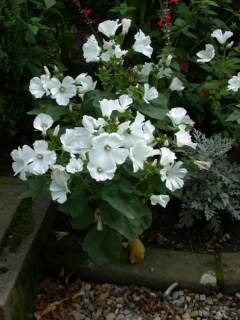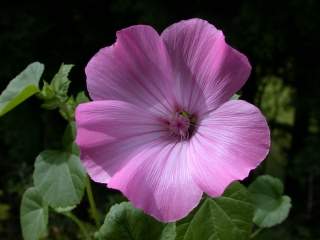
back to Contents and Overview

Lavatera trimestris L.
Lavatera trimestris var malvæformis Ball
Lavatera punctataAll.
Lavatera maroccana Maire
The best known annual Lavatera is L. trimestris L., the Rose, Royal or Regal Mallow, which is relatively isolated within Lavatera. L. mauritanica Durieu, a species from North Africa and Iberia, related to the Tree Mallows, is also of annual habit. The Tree Mallow, L. arborea L., and Smaller Tree Mallow, L. cretica L. are usually treated as biennials, but can be grown as annuals, as can the Australian Hollyhock, L. plebeia . A further group of 2 species related to both L. trimestris and to shrubby species such as L. olbia L. is of annual to biennial habit, and consists of L. punctata All. and L. maroccana Maire.
 Lavatera trimestris L.,
Lavatera trimestris L.,
![]() Rose Mallow, Royal Mallow, Regal Mallow, Annual Mallow,
Rose Mallow, Royal Mallow, Regal Mallow, Annual Mallow,
![]() Bechermalve, Garten-Strauchpappel, Trichtermalve,
Bechermalve, Garten-Strauchpappel, Trichtermalve,
![]() Bekermalva, Kaasjeskruid,
Bekermalva, Kaasjeskruid,
![]() sommarmalva, poppelros,
sommarmalva, poppelros,
![]() mamelukærme,
mamelukærme,
![]() Sommerstokkrose, Hagepoppelrose,
Sommerstokkrose, Hagepoppelrose,
![]() Aftanroðablóm,
Aftanroðablóm,
![]() Malva basta
Malva basta
![]() Kesämalvikki,
Kesämalvikki,
![]() aed-rõngaslill,
aed-rõngaslill,
![]() Vrtni grmièasti oslez,
Vrtni grmièasti oslez,
![]() Slazówka trójdzielna,
Slazówka trójdzielna,
![]() slézovec
tøímìsíèní,
slézovec
tøímìsíèní,
![]() flor de bispo
flor de bispo
Detailed description with photo-illustrations.
Distribution: Lavatera trimestris is found in the Mediterranean region, from Morocco, Portugal, Spain and Southern France to Turkey and the Levant, including the Balearic Islands, Corsica, Sardinia, Sicily, Malta and Greece. It is naturalised in other some other locations in Europe (e.g. Baden-Würtemmburg) and on other continents, including in the states of North Carolina, California, Texas, Vermont and Connecticut, and more generally in the mid-west and south-east of the USA, where it is often sold as an element in wildflower meadow seed mixes. In the British Isles it occurs as a casual in southern England.
Description: The annual Lavatera of gardens is L. trimestris L., the Rose, Royal or Regal Mallow. This is a tall upright annual (to 4 ft in the wild, but cultivated strains are often shorter) herb with bristly stems and showy bright pink (or white) flowers from 1-2 in across, occuring singly within the leaf axils, from mid-summer to late autumn. The lower leaves are 1-2 inches across, rounded tending to heart shaped; the upper leaves develop 3-7 lobes. The fruit is divided into around 12 ridged, seed-bearing, segments, covered by a disc-like expansion of the central axis.
Cultivation: L. trimestris is cultivated as an annual. Seed is sown indoors in early spring, or outdoors in late spring. The plant is reasonably tolerant of soil and aspect, but does best in a sunny location, and prefers well-drained, not over-fertile, soil. L. trimestris produces good seed in temperate climates, and sometimes self-sows.
It may also be treated as a half hardy biennial, seeds being sown indoors in autumn, and the plants overwintered indoors. When treated this way plants can be in bloom as early as April. (When treated this way plants are at risk of infestation with aphids. I also observed the loss of some plants by wilting - I suspect that the growing medium used was insufficiently moisture retentive.)
I have seen anecdotal reports that L. trimestris can be treated as a perennial, but that is inconsistent with its annual habit in the wild. In any case the mature plants are not frost-hardy, and cannot be overwintered outdoors in the British climate.
The cultivated strains are generally smaller, have larger flowers, and show a wider variety of colours. Strains include 'Deep Pink', 'Loveliness' (3-4 ft, deep rose-pink), 'Mont Blanc' (21 in, white), 'Mont Rose' (21 in, pink), 'Novella' (8-10 in, pink), 'Pastel' (mixed colours), 'Pink Beauty' (24 in, pale pink), 'Pink Regis' (presumable a paler pink version of 'Ruby Regis'), 'Rose Beauty' (24-30 in, pink), 'Ruby Regis' (24 in, cerise-pink), 'Salmon Beauty' (24-30 in, salmon pink?), 'Silver Cup' (24 in, pink), 'Splendens Alba', 'Splendens Sunset', 'Tanagra' (deep rose-pink), 'White Beauty' (24-30 in, white), 'White Cherub' (syn 'Dwarf White Cherub') (12-15 in, white), and 'White Regis' (presumably a white version of 'Ruby Regis').
'Parade' is a mixture of 'Mont Blanc', 'Pink Beauty', 'Ruby Regis' and 'Silver Cup'. 'Beauty Mix' is a mixture of 'Pink Beauty', 'Rose Beauty' and 'White Beauty' strains. 'Dutch Beauty', 'Easter Parade' and 'Pastel Mixed' are similar mixtures. 'Dutch Beauty' was bred for the cut flower trade.
A reference to a cultivar 'Silver Chalice' has been encountered. This may be the same as 'Silver Cup'.
 |
 |
 |
 |
 |
 |
 |
 |
 |
| Loveli- ness |
Mont Blanc |
Novella | Pink Beauty |
Rose Beauty |
Ruby Regis |
Silver Cup |
White Beauty |
White Cherub |
Photographs
photograph at Tel-Aviv University
photograph at Landskrona
photograph at Jardins-de-Sophie
photograph of cultivar ('Beauty') at botany.com
photograph of cultivar ('Deep Pink') at Perennial Pleasures Nursery
photograph of cultivar ('Mont Blanc') at World Seeds
photograph of cultivar ('Mont Blanc') at Cerny Seeds
photograph of cultivar ('Pink Beauty') at Perennial Pleasures Nursery
photograph of cultivar ('Ruby Regis') at World Seeds
photograph of cultivar ('Ruby Regis')
photograph of cultivar ('Silver Cup') at World Seeds
photograph of cultivar ('Silver Cup'?) at Ed Hume Seeds
photograph of cultivar ('Silver Cup') at Cerny Seeds
photograph of cultivar ('Tanagra') at eseeds.com
photographs of cultivars at Henriette's Herbal Homepage
photograph of naturalised plant in North Carolina
Lavatera punctata All.,
![]() Prickmalva
Prickmalva
Lavatera maroccana Maire
L. punctata is close to L. trimestris. It is found from Syria and Palestine, through Asia Minor, Turkish Thrace, Greece, Albania, and Italy, to southern France, Corsica and the Balearic Islands. It is present in Crete and Sicily, but not in Sardinia. It is doubtfully native to Spain. It is also found in Tunisia. It is smaller than L. trimestris - to 3 ft, and sometimes under a 1 ft in height. The stems are usually flushed with a purple-red colour, and are sparsely covered with stellate hairs. (Which distinguishes it from L. trimestris, which has green stems, and simple or few-rayed hairs.) The lower leaves are kidney shaped or semicircular, and shortly 5-lobed; its upper leaves are spear-shaped. The flowers are lilac-pink, occurring singly in the leaf axils.
Synonyms for L. punctata include Althaea punctata Kuntze, L.biennis Guss., L. micans Pau, L. thuringiaca Savi, Malva punctata (L.) Alef. and Olbia deflexa Presl.
L. maroccana Maire and L. punctata maroccana Batt. and Trabut are names applied to a population found in the Spanish provinces of Cadiz and Seville, and presumably also in Morocco. It is not separately listed in Flora Europaea, which presumably treats it as a population of L. punctata All. The populations from Caucasia and Iran have been separated as L. biennis M. Bieb, but these are not distinct from L. punctata All.1
References
If you have found any errors on this page, or have any further information about the genus Lavatera then please contact me at webmaster@meden.demon.co.uk.
back to Contents and Overview
text and photographs © 1999, 2000, 2002, 2003 Stewart Robert Hinsley